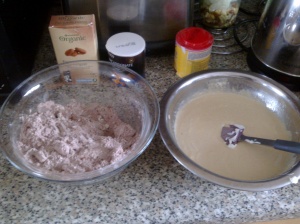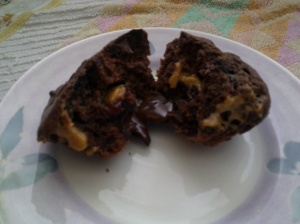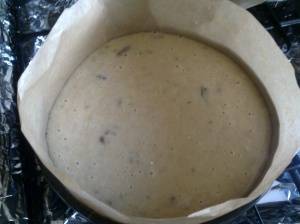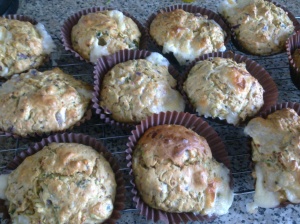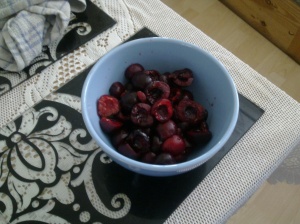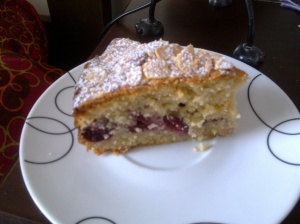As you might expect, I always bake a cake when my boyfriend’s birthday rolls round. This year, I wanted to put my newly acquired cake decorating skills (such as they are!) to the test and make something a little creative. After coming up with ideas including a Batman cake, Moomin cake, bee cake and snake cake, I settled on something a little more obscure – a cake based on a ship and aliens from a classic arcade game.
Unfortunately, my carefully laid plans went very wrong when I discovered that the extremely hot weather we had earlier in the week had resulted in my Mexican paste pretty much dissolving, so I couldn’t for the life of me cut out the shapes I needed to assemble the spaceship cake topper. After several attempts with various combinations of Mexican paste and sugarpaste, I abandoned the idea altogether and went for a simpler cake, still with a space theme.
So, let’s rewind a bit to the actual making of the cake itself. I wanted to make a Victoria sponge, but my usual port of call for this recipe wasn’t suitable because the cake needed to be heavy enough to take the weight of the sugarpaste icing I originally wanted to put on it. So instead, I made a round madeira cake. It was ridiculously easy to make (especially with an electric whisk handy!) and came out perfectly. I did, however, add some vanilla extract as I felt the recipe really needed it.
When it had cooled, I sliced off the domed part to create a flat top, then turned it upside down on to a cake board and sliced it into two layers. Next, I spread a layer of buttercream on the bottom cake and topped it with some strawberry jam before placing the other half of the cake on top. Then, I spread more buttercream all over the top and sides of the cake (I went on to add the sugarpaste layer and unsuccessfully cut out the shapes for the spaceship at this point, then took the sugarpaste off and added extra buttercream when I changed my mind).
Next, I sprinkled some edible silver balls and sugar stars all over the top and wedged five flying saucer sweets into the buttercream with the intention of making it look like the UFOs were flying through space. And that was pretty much it – much quicker than my original plan!
The cake went down extremely well with my boyfriend and the friends we shared it with while tackling the real ale rail trail from Manchester to Dewsbury and back. I thought it was delicious (even if I do say so myself!) and I’ll definitely make the madeira cake again. Whether I’ll attempt to apply my cake decorating skills again, though, is a different matter!
The recipe
For the madeira cake:
- 250g butter, softened
- 250g caster sugar
- 5 eggs
- 185g plain flour, sifted
- 60g self-raising flour, sifted
- 1 tbsp milk
- 0.5 tsp vanilla extract
For the filling and decorations:
- 200g butter, softened
- 280g icing sugar, sifted
- 0.5 tsp vanilla extract
- 170g good quality strawberry jam (I used half a jar of Hartley’s Best)
- Edible silver balls
- Sugar stars
- Flying saucer sherbet sweets
1. Preheat the oven to Gas 2-3/160C/315F. Grease a 20cm round cake tin and line the base.
2. Beat the butter and sugar until well mixed, fluffy and light. Beat in the eggs one at a time.
3. Fold in both the flours and stir in the milk and vanilla extract.
4. Transfer the mix to the tin and smooth the top. Bake for 1 hr 25 mins or until a skewer inserted into the middle comes out clean.
5. Leave to cool for 5 mins in the tin, then turn out on to a wire rack and cool completely (if you don’t, the filling will melt!). You can refrigerate the cake for up to 2 weeks or freeze for 2 months at this point.
6. Make the buttercream by beating the butter until it’s creamy and smooth, then beating in the icing sugar a little at a time. Mix in the vanilla extract.
7. Slice off the domed top of the cake and turn it upside down on a cake board. Slice it horizontally through the middle to create two layers.
8. Spread about one-third of the buttercream on the bottom cake layer and dollop the jam on top (try not to spread the buttercream and jam near the edge of the cake – it’ll all move outwards when you put the other cake layer on top).
9. Place the other half of the cake on top and press down gently. If the cake looks lopsided at this point, add more buttercream in the middle where it’s sloping down to make it look level.
10. Spread the remaining buttercream all over the top and sides. It’s okay if it’s not completely smooth!
11. Sprinkle the top liberally with silver balls and sugar stars. Wedge a few of the flying saucer sweets sideways into the buttercream to make it look as if they’re flying through the stars. You can either put the cake in the fridge for a couple of hours to make the buttercream set, or leave it out for more gooey icing.










